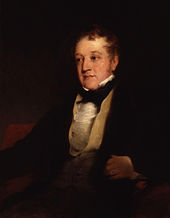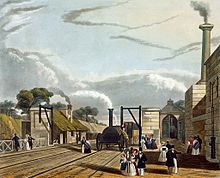William Huskisson
William Huskisson (born March 11, 1770 in Birtsmorton Court , Worcestershire , † September 15, 1830 in Eccles ) was British MP and Minister. Huskisson supported the construction of the Liverpool and Manchester Railway . He became known as the first prominent fatality in a railway accident , which occurred on the occasion of the opening of the line, when he was hit by the locomotive The Rocket and died a few hours later from his injuries.
Life
youth
Huskisson was the son of William and Elizabeth Huskisson, wealthy landowners in Staffordshire . William Huskisson was very susceptible to disease throughout his life. He still had three brothers. When his father married for the second time, William and one of his brothers went to Paris to live with his maternal great-uncle, Dr. Richard Gem, who was a doctor at the British Embassy. He took on the role of father for the two boys. After a few months, William was fluent in French .
William Huskisson showed a great talent for mathematics and was interested in social issues, politics and theater, for which Paris offered a wide field of study during the time of the French Revolution . He was an eyewitness to the storm on the Bastille and became a member of the Club de 1789 , which campaigned for the conversion of France into a constitutional monarchy . Out of curiosity, he once visited the Jacobin Club . Through his foster father he met Benjamin Franklin and Thomas Jefferson .
On August 29, 1790, at the Club de 1789, he gave a high-profile speech about the issue of assignats by the French government, which earned him the reputation of being a financial expert. From 1790 to 1792 he worked for the Marquess of Stafford , the British ambassador at the time. His sympathy for the French Revolution cooled as the violence increased. When the sans-culottes storm the Tuileries on August 10, 1792, Jean Louis Quentin de Richebourg, Marquis de Champcenetz, fled to William Huskisson's apartment in the British embassy. The two knew each other briefly. Huskisson succeeded in successfully enabling the Marquis de Champcenetz to escape to Great Britain. Paris was now definitely too hot a place and Huskisson returned to London in 1792 in the wake of the Marquess of Stafford .
family
On April 6, 1799, William Huskisson married Emily Milbanke († April 1856), the youngest daughter of Admiral Mark Milbanke , the commander of the port of Portsmouth . The marriage remained childless.
Politician
The Marquess of Stafford made it possible for Huskisson to get into politics in England by getting him a post in the administration and introducing him to politicians, including Home Secretary Henry Dundas and Prime Minister William Pitt the Younger . Since Huskisson spoke French fluently, Dundas commissioned him in January 1793 to enforce the Alien Act , which regulated the handling of mainly French refugees. He then became assistant to Evan Nepean , Deputy Minister for War and Colonies. Huskisson proved himself, so that in 1795 Pitt appointed him deputy head of this ministry himself when Nepean left.
In 1796 he was elected Member of Parliament for the constituency of Morpeth . He joined the Tories . He earned his living from the sale of his parents' lands and two inheritances that came to him during this time, one of them that of his great-uncle, Dr. According to
After Pitt's resignation in 1801, he gave up his position in the War and Colonial Department and his seat in Parliament. From 1804, when Pitt was back in office, Huskisson represented the constituency of Liskeard , from 1806 Harwich , and was Secretary of the Treasury until Pitt's death in January 1806 . Its main activity was to reorganize the relationship between the state and the Bank of England . During this time he was part of a group within the Tories that gathered around George Canning . He belonged to the liberal wing of the Tories. These stood for moderate parliamentary reform and the emancipation of Catholics . They relied on the growing middle class involved in trade and industry.
In 1810 he published a paper on the monetary system, which confirmed his reputation as the most capable financial expert of his time, but his free trade principles contradicted those of the majority of his party. In 1812 Huskisson returned to Parliament as a Chichester MP . He also took over the business for George Canning in Liverpool . George Canning had been elected representative of Liverpool in the House of Commons in 1812 , but was soon given the post of British Ambassador to Lisbon . Huskisson thus temporarily represented the interests of both constituencies . In 1823 he followed Canning in the parliamentary mandate for Liverpool.
From 1814 he led the administration for forests and forests ( First Commissioner of Woods and Forests ). In the debates about the Corn Laws he took a leading position in 1814/15 and initially spoke out in favor of these laws, which protected expensive domestic grain production from cheap imports and thus the price of grain - much to the detriment of consumers, but to their advantage for the landowners - held high.

In 1823 Huskisson became President of the Board of Trade , that is, Minister of Economics and Trade. His responsibility also extended to the emerging railways - initially mine railways that transported coal from the mines to canals , usually with horse-drawn wagons. His attitude towards the "Corn Laws" had meanwhile changed and he was now part of the camp that wanted to loosen or eliminate them. In a letter from November 1823, Huskisson criticized William Wilberforce and his abolitionist society, whose agitation he blamed for the slave revolts in Demerara . The letter was published in The Times in April 1824 .
In the spring of 1827 his political career seemed to be heading for new heights: his sponsor, George Canning, became Prime Minister of the United Kingdom and Huskisson remained President of the Board of Trade. The hoped-for career boost did not materialize: George Canning died after just 120 days in office, the shortest a British Prime Minister has ever held. His successor, Frederick John Robinson, 1st Viscount Goderich took over Huskisson as Secretary of War and Colonial Affairs . But the new Prime Minister also resigned soon, in May 1828. He was succeeded by the arch-conservative Duke of Wellington . He kept the "left" Torie Huskisson in the same capacity in his cabinet to keep the party's wings together. However, cooperation soon failed due to differences over parliamentary reform, Huskisson overran his position and finally had to resign from his ministerial post on May 19, 1829. Both in his time as minister and afterwards he supported the Liverpool and Manchester Railway project .
death
William Huskisson was the first celebrity to be killed in a railway accident while on September 15, 1830, as Guest of Honor and Member of Parliament for Liverpool, on the inaugural voyage of the Liverpool and Manchester Railway . In the literature, he is incorrectly named as the first person to ever die in a railway accident. He was buried in St James Cemetery in Liverpool. The rush to the funeral was so great that different tickets had to be issued in advance for the different parts of the cemetery. The funeral procession to the cemetery itself was 2 km long.
Commemoration
A marble statue of John Gibson was erected over his grave , showing William Huskisson in the clothes and pose of an ancient Roman senator . The statue was later in the Pimlico Gardens in London translocated .
Huskisson's widow had a bronze statue made by John Gibson set up in front of the Customs House in Liverpool on Canning Place . The customs house was destroyed by German bombs in World War II and the bronze sculpture was placed near the Princes Road Synagogue . The head of the statue was cut off during a dispute in 1981 and found in a park in 1984.
Various geographic objects are named after Huskisson:
- the Huskisson River in Tasmania , Australia
- The town of Huskisson in New South Wales in Australia
- the village of Huskisson Parish in New Brunswick in Canada
- the Huskisson Dock on the River Mersey in Liverpool
- the former Huskisson station in the vicinity of the dock of the same name
- the former Huskisson station of the Liverpool Overhead Railway near the dock of the same name
literature
- Simon Garfield: The Last Journey of William Huskisson . Faber and Faber, 2002. ISBN 0-571-21048-1 .
- John Andrew Hamilton: Huskisson, William . In: Sidney Lee (Ed.): Dictionary of National Biography . Volume 28: Howard - Inglethorpe. , MacMillan & Co, Smith, Elder & Co., New York City / London 1891, pp. 323 - 328 (English).
- AC Howe: Huskisson, William (1770-1830). In: Henry Colin Gray Matthew, Brian Harrison (Eds.): Oxford Dictionary of National Biography , from the earliest times to the year 2000 (ODNB). Oxford University Press, Oxford 2004, ISBN 0-19-861411-X , ( oxforddnb.com license required ), as of January 2008
- Huskisson, William . In: Encyclopædia Britannica . 11th edition. tape 14 : Husband - Italic . London 1911, p. 4 (English, full text [ Wikisource ]).
- J. Wright: Life of Huskisson , London 1831.
Web links
- William Huskisson at Hansard (English)
- Portrait of William Huskisson ( Memento from May 14, 2009 on the Internet Archive ) on historyhome.co.uk, as of May 14, 2009; accessed July 24, 2011
- Huskisson monument ( Memento from July 28, 2010 in the Internet Archive )
Individual evidence
- ^ Garfield, p. 59.
- ↑ Garfield, pp. 60f.
- ↑ Garfield, p. 62.
- ^ Garfield, p. 63.
- ↑ Garfield, pp. 72ff.
- ↑ Garfield, p. 74.
- ↑ Garfield, pp. 75f.
- ^ Garfield, p. 76.
- ^ Garfield, p. 76.
- ↑ Alexander Brady, William Huskisson and liberal reform
- ^ Garfield, p. 105.
- ^ Garfield, p. 106.
- ↑ Garfield, pp. 183ff.
- ↑ checkmatebooks.com William Huskisson ( Memento of the original from January 5, 2009 in the Internet Archive ) Info: The archive link was inserted automatically and has not yet been checked. Please check the original and archive link according to the instructions and then remove this notice.
| personal data | |
|---|---|
| SURNAME | Huskisson, William |
| BRIEF DESCRIPTION | British politician, member of the House of Commons |
| DATE OF BIRTH | March 11, 1770 |
| PLACE OF BIRTH | Birtsmorton Court , Worcestershire |
| DATE OF DEATH | September 15, 1830 |
| Place of death | Eccles |





